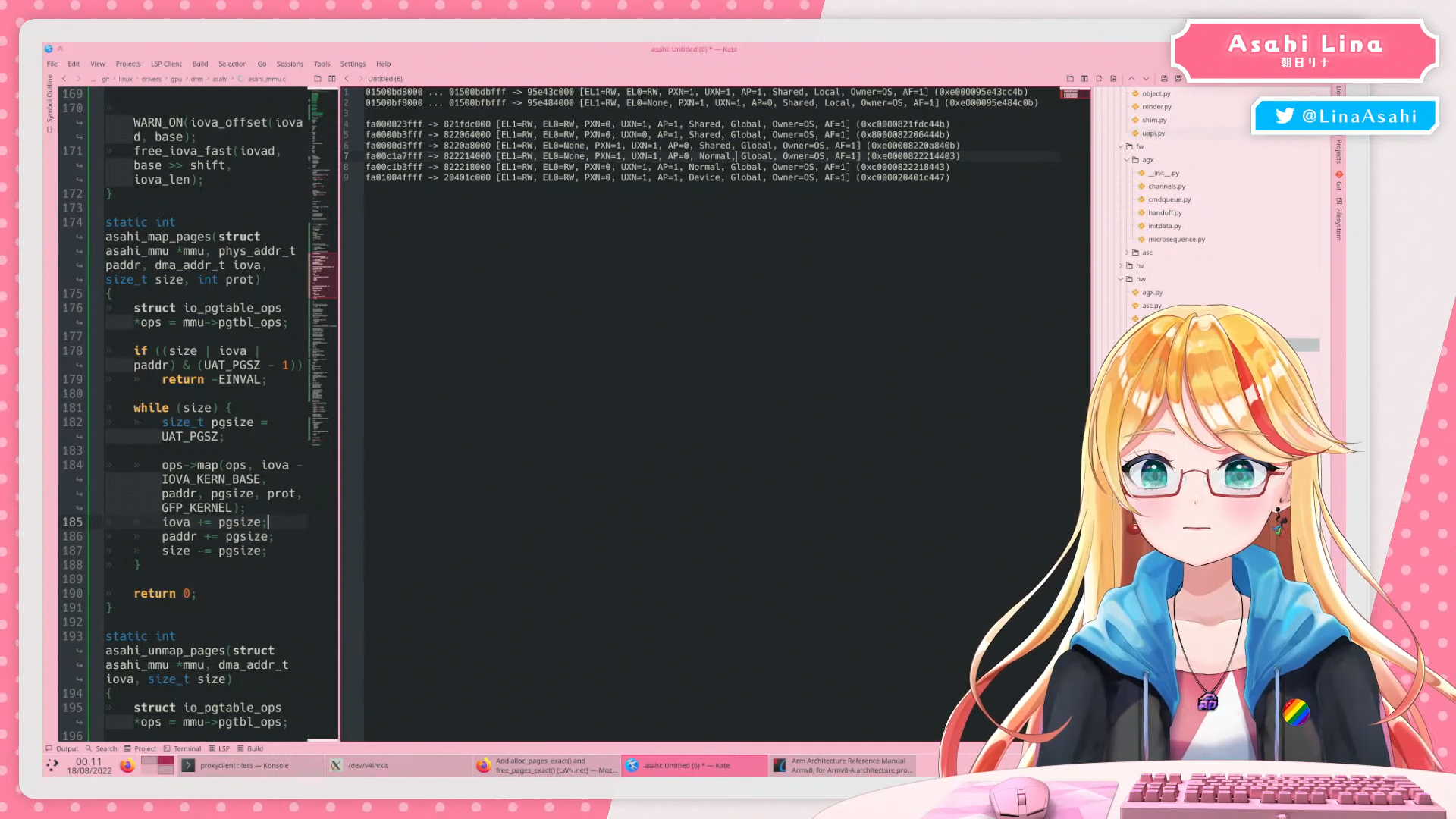I hacked macOS!!!
CVE-2022-32947
With Lina✨ & Cyan💎
On today's menu...
But first a demo!!!

GPU intro
CPU vs. GPU
How Apple GPUs work
That day in 2022...

Virtual Memory
What's a page table anyway?
Pointers
#include <iostream>
using namespace std;
int main() {
int a = 0;
void *p = &a;
cout << "&a is " << p << " nya!" << endl;
}&a is 0x7fffc6ba5ddc nya!This is a virtual address!
↓
0x7fffc6ba5ddc
↓
0x814745ddc
↑
This is the physical address!
How does this work?
GPU/CPU Memory
Page Tables
40 bits for virtual address (1 TiB)
16 KiB pages → 67,108,864 pages total
8 bytes per page address
=
512 MiB page table!!!!
Permissions
TTBAT
Translation Table Base Address Table
That day in 2022...

Hacking command buffers
Weird machines?
Command buffers
Micro Commands
00: -01: Wait For Idle02: Wait 203: Doorbell04: Write 8-bit reg05: Write 32-bit reg06: Write 64-bit reg07: -08: Read 8-bit reg09: Read 32-bit reg0a: Read 64-bit reg0b: Wait 32-bit reg0c: Wait 64-bit reg0d: -0e: Store 32-bit
0f: Store 64-bit10: Load 32-bit11: Load 64-bit12: ?13: ?14: ?15: Test (If)16: Logic op17: Add 16-bit18: Retire19: Timestamp1a: KTrace1b: ?1c: ?1d: ?
1e: Jump (Cond)1f: ?20: ?21: ?22: Start Vertex23: Finish Vertex24: Start Fragment25: Finish Fragment26: Start Blit27: Finish Blit28: ?29: Start Compute2a: Finish Compute2b: ?2c: ?
It's Turing Complete!
- 2 64-bit scratch registers
- Loads and stores (direct only)
- AND, OR, XOR, shifts
- Test for zero ("if")
- Jump / Conditional jump
Tricks
Indirect read/writes?R0 = *R1;
Tricks
Multiply?R1 = 10 × R0;
We can:
- Read/write firmware data memory
- Do math
We can't:
- Modify the firmware code
- Modify the page tables
But...
uPPL
More secrets...
uPPL can map memory!
- If page is uPPL: DENY
- If page is page table: DENY
- If page is secure uPPL/kernel data: DENY
- If page is TTBAT.... ??? ALLOWED!!!
They forgot to blocklist that one!!!!
Hack Idea
- Make fake PT that gives access to the real PTs
- Ask uPPL to give us access to the TTBAT
- Write fake PT to TTBAT (context 63 TTB0)
- Ask uPPL to activate context 63
- Write fake PT address to TTB1 page table
GPU can now read/write page tables directly!!
Problem
We can read/write stuff from the microsequence, but we can't call the uPPL...
We can't modify the firmware code directly...
Solution
Return-oriented Programming (ROP)!
Return-oriented programming
More weird machines????
Call and return
Multiple calls?
Challenge!
Data registers
Gadgets can be weird...
g_calltwo: Call two functions...
But the first argument is a pointer to a pointer to a pointer to the function
And the second one is a pointer to 0x70 before a pointer to the function
Gadgets can be weird...
g_store: Store a value to memory...
But it actually stores to the address you pass plus 0xa78
Exploit time!
This is going to be so yabai...
Putting it together
- Shader: Set up microseq and ROP chain data in unused memory
- Shader: Overwrite microseq pointers
- Microsequence: Calculate and fill in a lot of data using firmware info, then overwrite stack to start ROP
- ROP: Use uPPL bug and make a page table accessible to shaders
- Shader: Map more page tables and get access to ALL RAM
- Profit?????
It's hard to demo this all working in practice...
Challenge Accepted!

Microsequence registers
| R0 | 0x0000000000000000 | R1 | 0x0000000000000000 |
| X0 | |
| X1 | |
| X2 | |
| X3 | |
| X4 | |
| X5 | |
| X6 | |
| X7 | |
| X8 | |
| X9 | |
| X10 | |
| X11 | |
| X12 | |
| X13 | |
| X14 | |
| X15 | |
| X16 | |
| X17 | |
| X18 | |
| X19 | |
| X20 | |
| X21 | |
| X22 | |
| X23 | |
| X24 | |
| X25 | |
| X26 | |
| X27 | |
| X28 | |
| X29 | |
| LR | |
| SP | |
| PC |